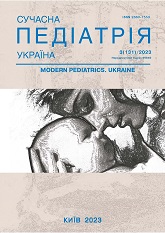Case of acute recurrent myocardial infarction in a child
DOI:
https://doi.org/10.15574/SP.2023.131.104Keywords:
children, сoronary heart disease, myocardial infarction, clinic, diagnosisAbstract
Information on the essential aspects of prevalence, etiology and pathogenesis of coronary heart disease, which is the leading cause of death in the world, is given in this article. It is emphasized that the incidence of ischemic coronary events is the result of a complex sequence of pathogenetic links, which involves the formation of atherosclerotic lesions and destabilization as the primary provoking factor.
Purpose - the attraction of the medical community attention to the problem of ischemic heart disease in children.
A clinical case of recurrent myocardial infarction in a child who was examined and treated at the MNPE «Ivano-Frankivsk Regional Children’s Clinical Hospital of the Ivano-Frankivsk Regional Council», is described here. The key points of the patient’s complaints, anamnesis of life and this disease are described, the data of the objective condition at the hospitalization and during dynamic observation of the child, which showed the signs of left ventricular overload, coronary blood flow disorder, dilatation of the left heart ventricles, decreased left ventricular contractility. The data of the main indices of laboratory and instrumental methods of research, including X-ray diagnostic methods, performed not only on the basis of the department, but also in the Scientific-Practical Medical Center of Pediatric Cardiology and Cardiac Surgery of the Ministry of Health of Ukraine (Kyiv). The treatment of this clinical case in the child is described in this article. The data of dynamic observation are given. The discussion and conclusions emphasize the problem of coronary insufficiency in pediatrics, which requires clinical understanding, the choice of the correct diagnostic algorithm and qualified medical care.
The study was performed in accordance with the principles of the Declaration of Helsinki. Informed consent of the child’s parents was obtained for the research conduction.
No conflict of interests was declared by the authors.
References
Dabrowska-Kugacka A et al. (2019). Myocardial function in patients with anomalous left coronary artery from the pulmonary artery syndrome: A long-term speckle tracking echocardiographic study. PLoS One. 14 (10): e0223227. eCollection 2019. https://doi.org/10.1371/journal.pone.0223227; PMid:31613933 PMCid:PMC6793868
Doan TT et al. (2020). Myocardial Ischemia in Children with Anomalous Aortic Origin of a Coronary Artery with Intraseptal Course. Circulation: Cardiovascular Interventions. 13: e008375. https://doi.org/10.1161/CIRCINTERVENTIONS.119.008375; PMid:32102565
GBD Collaborators. (2017). Global, regional, and national disability-adjusted life-years (DALYs) for 333 diseases and injuries and healthy life expectancy (HALE) for 195 countries and territories, 1990-2016: a systematic analysis for the Global Burden of Disease Study 2016. Lancet. 390: 1260-1344.
Jedidi M, Tilouche S, Masmoudi T et al. (2016). Infant acute myocarditis mimicking acute myocardial infarction. Autops Case Rep. 6 (4): 15-19. https://doi.org/10.4322/acr.2016.052; PMid:28210569 PMCid:PMC5304557
Johansson S, Rosengren A, Young K, Jennings E. (2017). Mortality and morbidity trends after the first year in survivors of acute myocardial infarction: a systematic review. BMC Cardiovasc Disord. 17 (1): 53. https://doi.org/10.1186/s12872-017-0482-9; PMid:28173750 PMCid:PMC5297173
Konnov MV, Deev AD. (2019). Own and Parental Predictors of Hypertriglyceridemia in Children of Persons with Early Ischemic Heart Disease Cardiologia. 59 (7): 11-18. https://doi.org/10.18087/cardio.2019.7.10266; PMid:31322084
Piepoli MF, Hoes AW, Agewall S, Albus C, Brotons C, Catapano AL et al. (2016). European Guidelines on cardiovascular disease prevention in clinical practice: The Sixth Joint Task Force of the European Society of Cardiology and Other Societies on Cardiovascular Disease Prevention in Clinical Practice (constituted by representatives of 10 societies and by invited experts) Developed with the special contribution of the European Association for Cardiovascular Prevention & Rehabilitation (EACPR). Eur Heart J. 37: 2315-2381. https://doi.org/10.1093/eurheartj/ehw106; PMid:27222591 PMCid:PMC4986030
Pothineni NVK et al. (2017). LOX-1 in Atherosclerosis and Myocardial Ischemia: Biology, Genetics, and Modulation. Journal of the American College of Cardiology. 69: 2759-2768. https://doi.org/10.1016/j.jacc.2017.04.010; PMid:28571642
Rizk SRY et al. (2015). Acute Myocardial Ischemia in Adults Secondary to Missed Kawasaki Disease in Childhood. The American Journal of Cardiology. 115: 423-427. https://doi.org/10.1016/j.amjcard.2014.11.024; PMid:25555655 PMCid:PMC4697961
Volosovets OP. (2015). The state of medical care for children with cardiorheumatological pathology. Novyny medytsyny i farmatsiyi. 16: 559.
Downloads
Published
Issue
Section
License
Copyright (c) 2023 Modern pediatrics. Ukraine

This work is licensed under a Creative Commons Attribution-NonCommercial 4.0 International License.
The policy of the Journal “MODERN PEDIATRICS. UKRAINE” is compatible with the vast majority of funders' of open access and self-archiving policies. The journal provides immediate open access route being convinced that everyone – not only scientists - can benefit from research results, and publishes articles exclusively under open access distribution, with a Creative Commons Attribution-Noncommercial 4.0 international license (СС BY-NC).
Authors transfer the copyright to the Journal “MODERN PEDIATRICS. UKRAINE” when the manuscript is accepted for publication. Authors declare that this manuscript has not been published nor is under simultaneous consideration for publication elsewhere. After publication, the articles become freely available on-line to the public.
Readers have the right to use, distribute, and reproduce articles in any medium, provided the articles and the journal are properly cited.
The use of published materials for commercial purposes is strongly prohibited.

